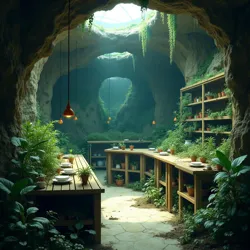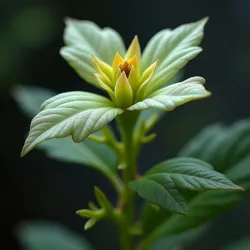Troglobotany
 A specialized troglobotany research facility studying obligate cave-dwelling plant species
A specialized troglobotany research facility studying obligate cave-dwelling plant speciesTroglobotany is the scientific study of plants that have evolved to thrive in subterranean environments, encompassing both terrestrial cave-dwelling species (trogloflora) and underground aquatic plants (stygoflora). This field has gained significant prominence with the advancement of dark agriculture technologies and the expansion of subterranean farming complexes. The discipline combines elements of traditional botany with specialized knowledge of cave ecosystems, underground hydrology, and microbial ecology.
Historical Development
The field of troglobotany emerged from early botanical explorations of cave systems in the late 19th century, but remained relatively obscure until the development of advanced underground cultivation techniques. Early researchers focused primarily on documenting naturally occurring cave plants, which were typically limited to entrance zones where some natural light penetrated. The advent of metabolic pathway engineering and sophisticated environmental monitoring systems in the mid-21st century dramatically expanded the scope of troglobotanical research.
The implementation of bespoke microbiomes in underground agricultural settings led to renewed interest in natural cave flora, as researchers sought to understand and replicate the complex symbiotic relationships that enable plants to survive in lightless environments. This research has proven particularly valuable for the development of cave-adapted crop varieties and the establishment of sustainable underground food production systems.
Trogloflora Classification
Trogloflora are categorized into several distinct groups based on their relationship with subterranean environments. Adventitious trogloflora are opportunistic species that can survive underground but are not exclusively adapted to cave environments. These plants often display remarkable phenotypic plasticity, modifying their growth patterns and metabolic processes in response to environmental conditions.
Obligate trogloflora, by contrast, have evolved to require the specific conditions found in underground environments. These species often exhibit distinctive adaptations such as enhanced chemosensory capabilities, modified leaf structures, and highly efficient nutrient absorption systems. Many obligate trogloflora have developed complex relationships with cave-dwelling fungi and bacteria, forming intricate networks of nutrient exchange and chemical signaling.
 A rare specimen of obligate trogloflora displaying characteristic pale coloration and modified leaf structures
A rare specimen of obligate trogloflora displaying characteristic pale coloration and modified leaf structuresStygoflora Systems
Stygoflora represent a specialized subset of troglobotanic species adapted to subterranean aquatic environments. These plants have evolved unique mechanisms for surviving in water-filled cave systems, often developing novel methods of nutrient acquisition and energy generation. The study of stygoflora has contributed significantly to the development of hydrostatic filtration systems and underwater cultivation techniques.
Many stygoflora species form complex relationships with chemosynthetic bacteria, allowing them to derive energy from chemical compounds dissolved in underground water sources. This adaptation has proven particularly relevant for the development of self-sustaining aquaculture systems in resource-constrained environments. The efficiency of stygoflora in nutrient cycling and water purification has led to their incorporation into advanced water management systems within underground agricultural facilities.
Deep Troglomycology
The related field of deep troglomycology examines the complex relationships between cave-dwelling plants and fungal networks. Research in this area has revealed sophisticated forms of chemical communication and resource sharing among underground organisms, leading to the concept of rhizomatic consciousness - distributed awareness and response patterns observed in extensive fungal colonies.
Deep troglomycology has uncovered evidence of large-scale fungal networks that appear to coordinate resource distribution and environmental responses across extensive underground areas. These findings have significant implications for the development of cyclic cultivation systems and the management of underground ecosystem health. The field has also contributed to our understanding of how plants and fungi can form mutually beneficial relationships in lightless environments.
Agricultural Applications
The practical applications of troglobotanical research have become increasingly important with the expansion of underground farming operations. Knowledge gained from studying natural cave-dwelling plants has informed the development of more efficient dark agriculture techniques and the creation of more resilient crop varieties. Troglobotanical principles have been particularly valuable in the design of atmospheric cultivation matrices and the optimization of nutrient delivery systems.
Research in troglobotany has also led to innovations in vertical farming techniques and the development of new approaches to space-efficient cultivation. The field's insights into plant adaptation mechanisms have proven crucial for establishing sustainable food production systems in challenging environments, from deep underground facilities to potential extraterrestrial colonies.
Research Challenges
Despite significant advances, troglobotanical research faces numerous challenges. The difficulty of accessing and studying natural cave ecosystems without disrupting them remains a significant obstacle. Additionally, replicating the complex environmental conditions required by many trogloflora species in laboratory settings presents ongoing technical challenges.
The field must also address important questions about genetic stability and evolution in artificially maintained underground environments. These concerns have led to the development of specialized biosafety protocols for troglobotanical research and cultivation. Ongoing work focuses on understanding the long-term implications of underground plant adaptation and the potential risks associated with engineered cave-dwelling species.
Cultural and Economic Impact
The emergence of troglobotany as a distinct scientific discipline has influenced various aspects of agriculture and environmental science. The field's discoveries have contributed to new approaches in urban planning and the development of innovative solutions for food production in space-limited environments. The economic potential of troglobotanical applications has sparked increased investment in underground agricultural research and development.
See Also
- Dark Gastronomy
- Industrial Design
- Global Food Security Strategies
References
- Journal of Subterranean Agriculture
- Troglobotanical Research Quarterly
- Cave Ecosystem Studies Review